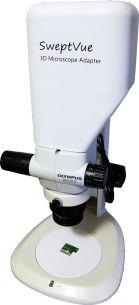One of the aspects of 3D printing that has been hailed as a great benefit is its ability to produce parts with a very high degree of precision. There are a variety of methods by which measurements 
Now, Swept Image is introducing an adapter call the SweptVue that allows close examination of the printed parts by connecting a USB3.0 camera and a digital light projector. As a result, engineers are able to accurately measure the micrometer-scale parts that they have had manufactured.
The system works by replacing the observation tube from an Olympus SZX7 stereo microscope allowing for digital line scanning by scattering light from one optical pathway into a Sony IMX035 CMOS image sensor. This scattered light is collected by an image sensor in a Flea3 industrial camera produced by Point Grey. A second optical pathway illuminates the object itself, making it visible to the eye. Using this system, images can be recorded at up to 120 frames per second.
The use of a stereo microscope structure allows for the triangulation of the data in order to measure depth. The light’s projection is synchronized as it is dispersed across the object with the position of the camera’s rolling shutter.
“While cameras with rolling shutters have been criticized for their performance when imaging moving targets, these characteristics were used to our advantage in the SweptVue system. By synchronizing the illumination pattern on the part with the rolling shutter, light returned from different heights on the part is shifted laterally at the sensor, enabling features to be captured at specific depths. What is more, we can quickly shift between depths by changing the trigger delay on the Flea3 camera.”
